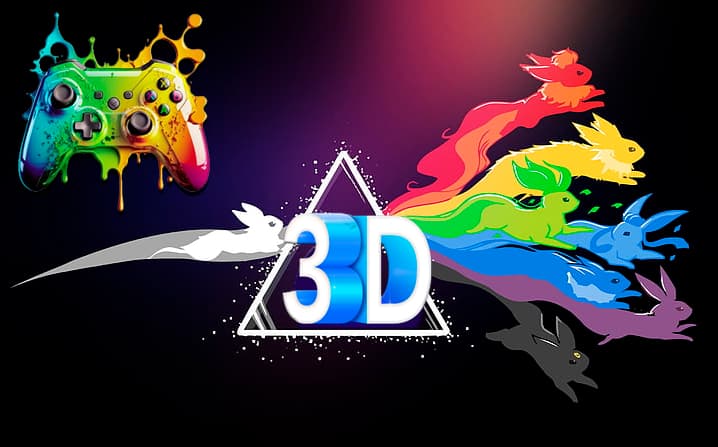The Evolution of 3D Graphics in Game Development

Within the dynamic field of video betting, the introduction of 3D graphics represents a significant turning point. It completely changed player interaction, the fundamentals of production, and the gaming experience itself. This evolution was not a sudden occurrence but a gradual convergence of progressive technological strides and creative explorations.
Beginning with rudimentary polygonal structures, the journey to today’s remarkably realistic virtual worlds showcases the continuous push of creativity and technology’s boundaries. Our exploration delves into the historical progression and transformation of 3D graphics in gaming.
We’ll highlight critical junctures and technological breakthroughs that have charted this course. Our focus will extend to understanding how these advancements have fundamentally altered design and reshaped the betting experience, paving the way for future breakthroughs. These innovations herald an exciting period in the history of gaming and continue to excite and amaze players everywhere.
Breaking New Ground: Exploring the Origins of 3D in Gaming
The introduction of graphics in betting games brought about a change, taking players from plain two-dimensional interfaces to captivating environments that are full of depth and realism. This journey began in the late 1970s, characterized by primitive wireframe graphics. Notable games like “Battle zone” (1980) were at the forefront, introducing a first-person view in a 3D space, a novelty at the time.
This was a significant turning point, disrupting the conventional betting format and setting the stage for ongoing technological evolution. The introduction of these early 3D graphics, although basic compared to current standards, was a crucial step in reshaping the gaming industry.
It opened a new era where the virtual experience began to closely mimic real-world perceptions, enhancing the gamer’s engagement and immersion. This breakthrough not only changed how games were played, but also sparked a continuous drive for innovation in graphics technology.
As a result, developers started to delve into opportunities in design, which resulted in the emergence of intricate and authentic graphics. This progression has played a role in enhancing the gaming experience by making it more captivating and true to life.
Furthermore, it serves as a source of inspiration for advancements, in 3D technology ultimately revolutionizing the realm of betting games.
Crafting Virtuality: Essential Software and Tech in 3D Game Design
The evolution of 3D design, driven by remarkable advancements in software and technology, has seen several key developments:
- Early Rendering Techniques: In the nascent stages of 3D betting, developers grappled with significant hardware limitations. The reliance on basic rendering techniques defined this era, with simple polygonal shapes and limited textures.
- Introduction of GPUs: The development of Graphics Processing Units (GPUs) marked a significant turning point. GPUs accelerated the rendering process, allowing for more complex and detailed graphics.
- Enhanced Realism and Complexity: These technological strides allowed game designers to craft environments with unprecedented levels of detail and realism. The result was a new benchmark in betting, characterized by stunningly immersive virtual worlds.
- Translation of Artistic Visions: With advanced technology at their disposal, designers could now translate their most intricate and ambitious visions into reality, pushing the boundaries of creativity in design.
Merging Creativity with Technology: Designing 3D Game Environments
Designing environments is an intriguing blend of creative artistry and technical skill. It requires an endeavour where artists and engineers unite to construct captivating worlds that faithfully replicate real-world physics and interactions.
Through the utilization of lighting techniques, designers can craft immersive environments. These detailed settings provide gamers with an extraordinary level of immersion. The fusion of artistic vision and technological innovation turns basic code and pixels into dynamic, engaging worlds that enthral players.
Transforming the Play: How 3D Graphics Redefine Gaming Experiences
The world of betting has changed dramatically with the advent of sophisticated graphics. The addition of three-dimensional depth and spatial sense has greatly increased the realism and replayability of games. This increase in realism extends beyond the graphics and affects the gaming mechanics as well, creating settings that are more dynamic and interactive.
Gamers nowadays have expectations when it comes to gaming experiences. The transition, from two-dimensional to three designs has played a role, in shaping these expectations. As a result, betting has transformed into a form of entertainment, where users actively engage with lifelike virtual environments.
Navigating the Complexities: Addressing Challenges in 3D Game Development
The process of making a video game is complex and full of special difficulties, like overcoming creative and technological roadblocks. The difficult task of balancing fluid performance and excellent graphics across a variety of platforms falls on developers.
They also explore the intricacies of creating textures, simulating realistic physics, and 3D modelling. The development of engines and real-time rendering, which has allowed creators to push the envelope of what is possible in betting games, has been essential to conquering these obstacles.
On the Horizon: Anticipating the Future of 3D Gaming
The field of betting is full of opportunities because of the constant advancement of technology and the desire for new ideas. The gaming business could undergo a complete transformation thanks to new technologies like virtual reality (VR) and augmented reality (AR), which offer more engaging and immersive experiences. AI and machine learning advancements are predicted to pave the way for incredibly adaptable and engaging gaming experiences.
We can look forward to a time when 3D games become ever more accurate as rendering techniques and hardware performance continue to advance, thereby obfuscating the distinction between the virtual and real worlds.
